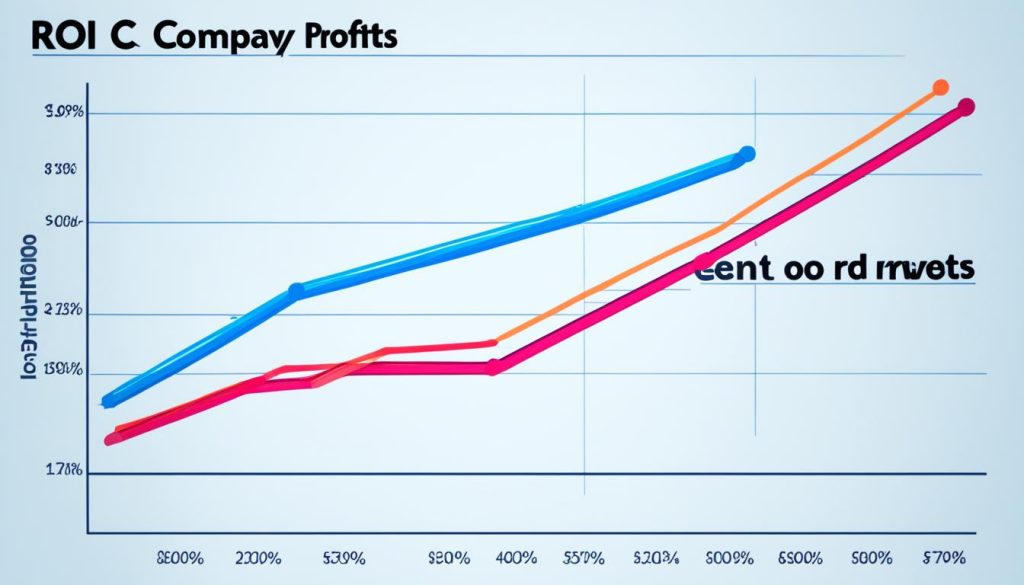Return on Investment (ROI) is a widely used metric in business to evaluate the profitability of an investment. ROI measures the financial returns generated by an investment in relation to the initial investment amount. It is usually expressed as a percentage and is calculated by dividing the net profit of an investment by the total cost of the investment.
ROI is applicable to various industries and types of investments, including marketing campaigns, stock investments, and business ventures. It helps businesses and investors make informed decisions about resource allocation and compare different investment opportunities. A higher ROI indicates a more profitable investment, while a lower ROI suggests lower returns.
Calculating and tracking ROI is essential for measuring investment performance and making informed business decisions. To learn more about the definition, calculation, and importance of ROI, continue reading.
What is ROI?
ROI, or Return on Investment, is a financial metric used in business to assess the profitability of an investment. It measures the amount of money gained or lost relative to the initial investment amount. ROI is expressed as a percentage, providing a standardized way to evaluate the effectiveness of an investment.
Businesses and investors use ROI to compare different investment opportunities and make informed decisions about resource allocation. It considers both the total cost of the investment and the net profit generated, making it a comprehensive metric for evaluating investment performance.

By calculating ROI, businesses and investors can determine the percentage return on their investment and assess its profitability. It helps in identifying the most profitable investments, optimizing investment strategies, and measuring investment success.
How to Calculate ROI?
Calculating ROI is relatively straightforward. To calculate ROI, you need to divide the net profit of an investment by the total cost of the investment and then multiply the result by 100 to get the percentage. The formula for calculating ROI is as follows:
ROI = (Net Profit / Total Cost of Investment) x 100%
The net profit is the total revenue generated by the investment minus its associated costs, while the total cost of the investment includes all the expenses incurred to acquire, operate, and maintain the investment. By using this formula, businesses and investors can determine the percentage return on their investment and assess its profitability.

| Net Profit | Total Cost of Investment | ROI |
|---|---|---|
| £50,000 | £100,000 | 50% |
| £75,000 | £125,000 | 60% |
| £100,000 | £200,000 | 50% |
Why is ROI important?
ROI, or return on investment, is a crucial metric for businesses and investors to evaluate the performance of their investments. It plays a vital role in decision-making and resource allocation, and understanding its importance is essential for financial success.
Evaluating investment performance: ROI helps businesses and investors assess the returns generated by different investments. By calculating ROI, they can compare the profitability of various options and identify the most lucrative ones.
Identifying areas for improvement: Analyzing factors that affect ROI allows businesses and investors to make adjustments and optimize their investment strategies. By identifying areas for improvement, they can enhance the overall profitability of their investments.
Guiding resource allocation: ROI enables businesses and investors to allocate their resources strategically. By focusing on investments with higher ROI, they can maximize their returns and make informed decisions about where to allocate their resources.
Measuring investment success: ROI serves as a measure of investment success. It provides accurate and reliable data on investment performance, helping businesses and investors track progress and make informed decisions based on the financial returns generated.
Communication tool: ROI allows businesses and investors to share information about investment performance with stakeholders. It serves as a communication tool to convey the success and profitability of their investments, building trust and confidence.
To illustrate the importance of ROI, let’s consider an example:
| Investment | Net Profit | Total Cost of Investment | ROI |
|---|---|---|---|
| Marketing Campaign A | £100,000 | £50,000 | 200% |
| Marketing Campaign B | £80,000 | £70,000 | 114.29% |
In the above example, Marketing Campaign A has a higher ROI of 200% compared to Marketing Campaign B with an ROI of 114.29%. This indicates that Marketing Campaign A is more profitable and provides a better return on investment.
Overall, ROI is a vital metric that helps businesses and investors evaluate investment performance, allocate resources effectively, and make informed decisions for financial success.

Challenges to Determining ROI
Determining ROI can present several challenges that businesses and investors need to navigate. These challenges can affect the accuracy and reliability of ROI calculations, making it difficult to assess investment performance and compare different opportunities.
- Overlap of Investments: One challenge in determining ROI is the potential overlap of investments. When multiple investments are made in the same period, it becomes challenging to identify which investment contributed the most to the overall ROI. This makes it harder to allocate resources effectively and evaluate the success of individual investments.
- Impact of External Factors: Another challenge arises from the consideration of external factors that can impact ROI. Ongoing investments, market conditions, and changes in consumer behavior can all influence the financial returns generated. These factors need to be carefully taken into account to ensure a comprehensive analysis and accurate ROI calculation.
- Timeframe and Opportunity Costs: The timeframe and passage of time can also pose challenges to determining ROI. Longer investment durations or delays in achieving desired outcomes can affect the overall profitability. Additionally, the opportunity costs of investing elsewhere need to be considered when evaluating the potential returns of a particular investment.
Despite these challenges, ROI remains a valuable metric for assessing investment performance and comparing different opportunities. With careful analysis and consideration of these challenges, businesses and investors can make informed decisions and optimize their investment strategies.
How to Increase Your ROI?
Increasing ROI requires strategic decision-making and implementation of effective tactics. Businesses and investors can increase their ROI by using tools with advanced analytics capabilities, such as platforms and software that provide comprehensive reporting features. Effectively connecting with the target audience is also crucial for boosting ROI.
- Invest in market research: Conduct thorough research to understand your target market and their preferences. This data will help you create more targeted and effective marketing campaigns.
- Create targeted ad campaigns: Use the insights gained from market research to design ad campaigns that resonate with your target audience. Tailor your messaging, visuals, and calls to action to maximize engagement and conversions.
- Enhance customer engagement: Foster strong relationships with your customers by providing exceptional customer service and personalized experiences. Engage with them through social media, email marketing, and loyalty programs to deepen their connection with your brand.
- Experiment with new ideas and tactics: Don’t be afraid to try new strategies and approaches. Conduct A/B testing and analyze the results to identify what works best for your business and drives the highest ROI.
- Consider ROI in decision making: Make ROI a key consideration in all your business decisions. Evaluate the potential returns of different investments and initiatives to ensure you are allocating resources effectively.
By following these steps, businesses and investors can increase their ROI and optimize the performance of their investments. Continuous improvement, data-driven analysis, and effective targeting are essential for achieving higher returns.

| Techniques to Increase ROI | Description |
|---|---|
| Utilize advanced analytics tools | Invest in platforms and software that provide detailed analytics and reporting capabilities. These tools can help you track and analyze key metrics, identify areas for improvement, and make data-driven decisions. |
| Segment your audience | Divide your target market into smaller segments based on demographics, preferences, or behavior. This allows you to tailor your marketing efforts to each segment, delivering more personalized and relevant messaging. |
| Optimize your website and landing pages | Ensure that your website and landing pages are user-friendly, optimized for search engines, and designed to convert visitors into customers. A well-designed and optimized website can significantly improve your ROI. |
| Invest in customer retention | Acquiring new customers can be more expensive than retaining existing ones. Focus on building customer loyalty and providing exceptional post-purchase experiences to increase customer retention rates and overall ROI. |
| Track your marketing campaigns | Implement comprehensive tracking and attribution tools to monitor the performance of your marketing campaigns. By analyzing the data, you can identify the most effective channels and tactics, allowing you to optimize your marketing spend and increase ROI. |
Implementing these techniques, along with continuous monitoring and optimization, can help businesses and investors enhance their ROI and achieve their financial goals.
Conclusion
ROI, or Return on Investment, is a crucial metric for evaluating the profitability of investments and making informed business decisions. It allows businesses and investors to measure the financial returns generated by an investment compared to the initial investment amount. Calculating ROI provides insights into investment performance, identifies areas for improvement, and enables effective resource allocation to achieve investment goals.
Despite the challenges in determining ROI, it remains a valuable tool for evaluating the effectiveness of investments. Strategies such as utilizing advanced analytics, implementing targeted marketing campaigns, and conducting experimentation can help businesses and investors increase their ROI. By analyzing investment performance, making data-driven decisions, and continuously refining investment strategies, businesses can improve their financial success.
If you want to calculate your ROI, you can use online tools like the Return on Investment Calculator or the Rental Yield Calculator. These calculators simplify the calculation process and provide accurate results. Remember to use the ROI formula: ROI = (Net Profit / Total Cost of Investment) x 100%. By utilizing these resources and implementing effective strategies, businesses and investors can optimize their investment performance and achieve their financial goals.





